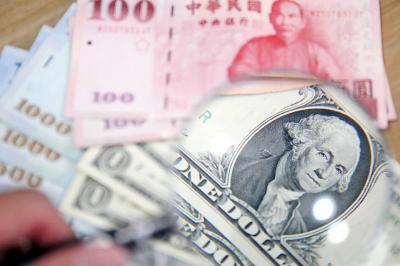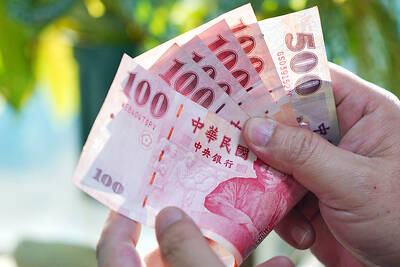The safe-haven US dollar on Friday slipped from a nine-and-a-half-month high as risk appetite improved, with equities gaining and benchmark US Treasury yields higher, although the near-term outlook for the greenback remained upbeat.
The US currency remained supported overall by concerns that the Delta variant of SARS-CoV-2 could derail global economic recovery just as central banks begin to reverse COVID-19 pandemic-related stimulus.
The US dollar index, which measures the US currency against six rivals, rose to as high as 93.734 for the first time since early November last year, before trading 0.1 percent lower at 93.491. For the week, it posted a 1 percent gain, the most in two months.
In Taipei, the New Taiwan dollar fell against the greenback, losing NT$0.039 to close at NT$28.008, falling 0.5 percent for the week.
While moves in currency markets were much more contained than on Thursday as equity markets steadied, the risk-sensitive Australian and New Zealand dollars were mixed, but their overall bias remained tilted to the downside.
“In the near term, we expect the dollar to appreciate a bit further,” Capital Economics senior markets economist Jonas Goltermann wrote in his latest research note.
“We think that robust growth in the US relative to other major economies and a gradual tightening of monetary policy will put further upward pressure on the greenback,” he wrote.
The Australian dollar sank to a new nine-and-a-half-month low of US$0.7107, and was down 0.2 percent at US$0.7137. On the week, the Aussie fell 3.3 percent, its worst weekly performance since September last year, as a COVID-19 lockdown on Sydney was extended by a month.
The New Zealand dollar dipped to a new nine-month trough of US$0.6807 at one point. It last traded up 0.2 percent at US$0.6838.
The Canadian dollar dropped to an eight-month-low of C$1.2948 per US dollar and was last at C$1.2840, down 0.1 percent against its US counterpart as oil prices fell further because of worries about the global economy.
Norway’s krone dropped for a second day as weaker oil prices and general nervousness among investors hit the currency despite the Norwegian central bank on Thursday sticking to its plan for an interest rate hike next month.
The euro was up 0.2 percent at US$1.1697, not far from the nine-and-a-half-month low of US$1.1665 reached overnight.
Against the yen, another safe-haven currency, the US dollar was flat at ¥109.80.
The British pound slipped to one-month lows versus the US dollar, and was last down 0.1 percent at US$1.3622.
Additional reporting by CNA, with staff writer

The US dollar was trading at NT$29.7 at 10am today on the Taipei Foreign Exchange, as the New Taiwan dollar gained NT$1.364 from the previous close last week. The NT dollar continued to rise today, after surging 3.07 percent on Friday. After opening at NT$30.91, the NT dollar gained more than NT$1 in just 15 minutes, briefly passing the NT$30 mark. Before the US Department of the Treasury's semi-annual currency report came out, expectations that the NT dollar would keep rising were already building. The NT dollar on Friday closed at NT$31.064, up by NT$0.953 — a 3.07 percent single-day gain. Today,

‘SHORT TERM’: The local currency would likely remain strong in the near term, driven by anticipated US trade pressure, capital inflows and expectations of a US Fed rate cut The US dollar is expected to fall below NT$30 in the near term, as traders anticipate increased pressure from Washington for Taiwan to allow the New Taiwan dollar to appreciate, Cathay United Bank (國泰世華銀行) chief economist Lin Chi-chao (林啟超) said. Following a sharp drop in the greenback against the NT dollar on Friday, Lin told the Central News Agency that the local currency is likely to remain strong in the short term, driven in part by market psychology surrounding anticipated US policy pressure. On Friday, the US dollar fell NT$0.953, or 3.07 percent, closing at NT$31.064 — its lowest level since Jan.

The Financial Supervisory Commission (FSC) yesterday met with some of the nation’s largest insurance companies as a skyrocketing New Taiwan dollar piles pressure on their hundreds of billions of dollars in US bond investments. The commission has asked some life insurance firms, among the biggest Asian holders of US debt, to discuss how the rapidly strengthening NT dollar has impacted their operations, people familiar with the matter said. The meeting took place as the NT dollar jumped as much as 5 percent yesterday, its biggest intraday gain in more than three decades. The local currency surged as exporters rushed to

PRESSURE EXPECTED: The appreciation of the NT dollar reflected expectations that Washington would press Taiwan to boost its currency against the US dollar, dealers said Taiwan’s export-oriented semiconductor and auto part manufacturers are expecting their margins to be affected by large foreign exchange losses as the New Taiwan dollar continued to appreciate sharply against the US dollar yesterday. Among major semiconductor manufacturers, ASE Technology Holding Co (日月光), the world’s largest integrated circuit (IC) packaging and testing services provider, said that whenever the NT dollar rises NT$1 against the greenback, its gross margin is cut by about 1.5 percent. The NT dollar traded as strong as NT$29.59 per US dollar before trimming gains to close NT$0.919, or 2.96 percent, higher at NT$30.145 yesterday in Taipei trading